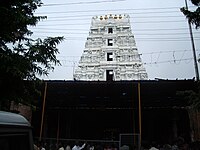Reddi Kingdom
Reddi kingdom | |||||||||||
|---|---|---|---|---|---|---|---|---|---|---|---|
| 1325–1448 | |||||||||||
Kondavidu Rajahmundry | |||||||||||
| Common languages | Telugu | ||||||||||
| Religion | Hinduism | ||||||||||
| Government | Monarchy | ||||||||||
| Historical era | Medieval India | ||||||||||
• Established | 1325 | ||||||||||
• Disestablished | 1448 | ||||||||||
| |||||||||||
The Reddi kingdom or Kondavidu Reddi kingdom (1325–1448 CE)
Etymology
The Telugu term "Reddi", whose earlier forms were "Raddi", "Rattodi", and "Rattakudi", linked to the Sanskrit term "Rashtrakuta", was used for village headmen, who were responsible for organising the cultivation of the agricultural lands of the villages and collecting taxes. From the seventh century, some of the members of the Rattakudi families had important posts in the administration of the kingdoms.[4] A copperplate record mentioned the grandfather of the founder of the dynasty as a sainya-nayaka, a commander of the forces.[5]
Origin
The fall of the Kakatiya Kingdom in 1323, after being subject to seizures by the Tughlaq dynasty, led to a political vacuum in the Andhras.The Islamic conquerors failed to keep the region under effective control and constant infighting among themselves coupled with the martial abilities of the local Telugu warriors led to the loss of the entire region by 1347.[6][verification needed]
Whilst, this led to the rise of the Musunuris (initially were based in Coastal Andhra) and Recharlas in the Telangana region, the coastal belt saw the rise of a third warrior lineage—the Reddis of the Panta clan.[7][verification needed]
Established in about 1325 by Prolaya Vema Reddi,(also known as Komati Vema), his territory extended along the coast to Nellore in the south and Srisailam, in the west. He was succeeded by Anavota Reddi who consolidated the kingdom extensively and established its capital at Kondavidu in Guntur District.[7][verification needed]
By 1395, a second Reddi kingdom was established by a branch of the same lineage, with its capital in Rajahmundry, East Godavari District.[7][verification needed]
The Reddi kings’ ancestors were part of the Kakatiya military and held important posts such as the sainya-nayaka. [5][7][8] [verification needed]
Extent of rule

The Reddi kings ruled
Religion


The Reddi rulers played a prominent part in post-
It was during this chaotic period in Andhra history that Prolaya Vema Reddi established the Reddi kingdom in 1325. The Reddi rulers patronised and protected Hinduism and its institutions. The Brahmins were given liberal grants by the Reddi kings and the agraharas of Brahmins were restored. Vedic studies were encouraged. The Hindu temples of Srisailam and Ahobilam were provided with more facilities. Prolaya Vema Reddi bestowed a number of agraharas on the Brahmins. He was revered by the title of Apratima-Bhudana-Parasurama.[16] He commissioned major repairs to the Srisailam Mallikarjuna Swami temple, and had a flight of steps built from the Krishna River to the temple. The Narasimha Swamy temple at Ahobilam was built during his reign. He built 108 temples for Shiva.[17]
Literature
Administration
| Reddi Kings[18] (1325–1448 CE) | |
| Prolaya Vema Reddi | (1325–1353) |
| Anavota Reddi | (1353–1364) |
| Anavema Reddi | (1364–1386) |
| Kumaragiri Reddi | (1386–1402) |
| Kataya Vema Reddi | (1395–1414) |
| Peda Komati Vema Reddi | (1402–1420) |
| Racha Vema Reddi | (1420–1424) |
| Allada Reddi | (1414–1423) |
| Veerabhadra Reddi | (1423–1448) |
The administration was carried according to the "Dharmasutras". One-sixth of agriculture surplus was levied as tax. Under the reign of Anavota Reddi custom duties and taxes on trade were lifted. As a result, trade flourished. Sea trade was carried through the port Motupalli. A large number of merchants settled down near it. Celebrating 'Vasantotsavalu' was revived during the rule of Anavema Reddi. The Brahmins were given liberal grants by the Reddi kings. Caste system was observed. Heavy taxes by Racha Vema Reddi made him highly unpopular.[19]
See also
Notes and references
- ISBN 0226742210.
- ^ Talbot 2001, p. 202.
- ^ Farooqui 2011, pp. 117–118.
- ^ Somasekhara Sarma 1946, pp. 70–75.
- ^ a b Somasekhara Sarma 1946, pp. 66–67.
- ^ Talbot 2001, p. 176.
- ^ a b c d Talbot 2001, p. 177.
- ^ "Reddi Kula Nirnaya Chandrika, Sheshadri Ramana Kavulu".
- ^ a b Rao & Shulman, Srinatha 2012, p. 16.
- ^ Raghunadha Rao 1994, p. 82.
- ^ Durga Prasad 1988, p. 173.
- ^ Durga Prasad 1988, pp. 174, 177.
- ^ a b c Raghunadha Rao 1994, p. 83.
- ISBN 978-0-415-32919-4. Retrieved 16 August 2011.
- ISBN 9780836422832. Retrieved 5 August 2011.
- ISBN 978-81-7156-062-2. Retrieved 2 September 2011.
- ^ Raghunadha Rao 1994, p. 89.
- ^ Somasekhara Sarma 1946, p. 47.
- ^ Raghunadha Rao 1994, pp. 87, 88.
Book sources
- Farooqui, Salma Ahmed (2011), A Comprehensive History of Medieval India: From Twelfth to the Mid-Eighteenth Century, Pearson Education India, ISBN 978-81-317-3202-1
- Durga Prasad, G. (1988), History of the Andhras up to 1565 A. D. (PDF), Guntur: P. G. Publishers, archived from the original (PDF) on 14 February 2019, retrieved 27 August 2018
- Raghunadha Rao, P. (1994), History and Culture of Andhra Pradesh: From the earliest times to the present day, Sterling Publishers, ISBN 81-207-1719-8
- Rao, Velcheru Narayana (2003). "Multiple Literary Cultures in Telugu: Court, Temple and Public". In Sheldon I. Pollock (ed.). Literary cultures in history: reconstructions from South Asia. University of California Press. pp. 383–436. ISBN 978-0-520-22821-4.
- Rao, Velcheru Narayana; Shulman, David (2012), Srinatha: The Poet Who Made Gods and Kings, Oxford University Press, ISBN 978-0199863044
- Somasekhara Sarma, Mallampalli (1946), History of the Reddi Kingdoms (Circa. 1325 A.D., to circa. 144B A.D.), Waltair: Andhra University – via archive.org
- Talbot, Cynthia (2001), Pre-colonial India in Practice: Society, Region, and Identity in Medieval Andhra, Oxford University Press, ISBN 978-0-19803-123-9
